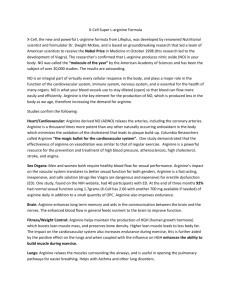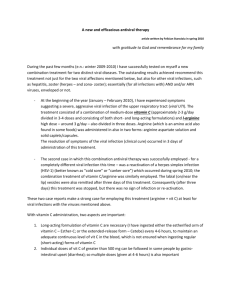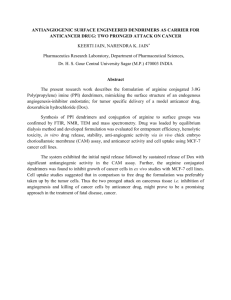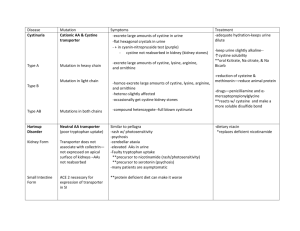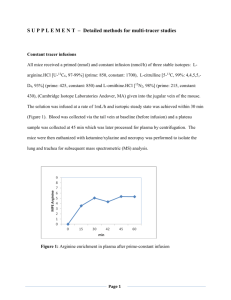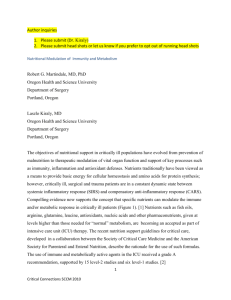The Effect of Arginine on Coagulation and Fibrinolysis In Vitro
advertisement
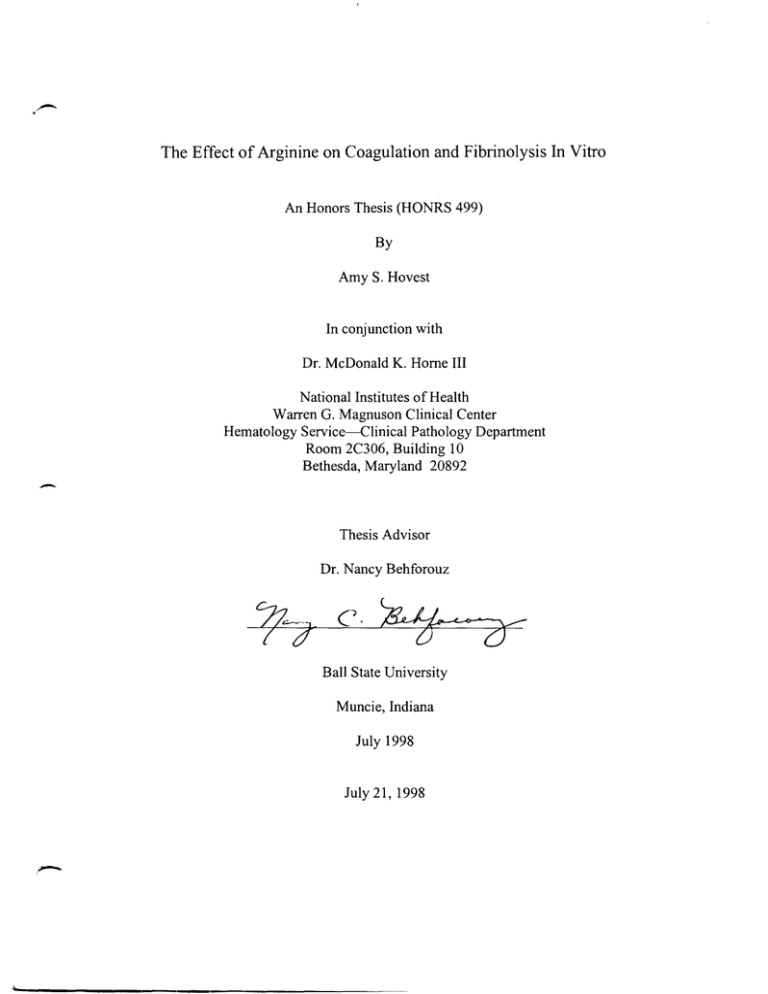
The Effect of Arginine on Coagulation and Fibrinolysis In Vitro An Honors Thesis (HONRS 499) By Amy S. Hovest In conjunction with Dr. McDonald K. Home III - National Institutes of Health Warren G. Magnuson Clinical Center Hematology Service-Clinical Pathology Department Room 2C306, Building 10 Bethesda, Maryland 20892 Thesis Advisor Dr. Nancy Behforouz Ball State University Muncie, Indiana July 1998 July 21,1998 ... - SUMMARY Arginine is added to commercially available recombinant tissue plasminogen activator (rtPA) to promote its solubility. However, arginine is also known to inhibit certain proteases. To explore the possibility that arginine inhibits the highly concentrated rtP A in commercial formulations, we tested the amino acid in assays of tP A function. Although arginine was found to inhibit rtP A cleavage of a chromogenic substrate, it did not interfere with rtPA-mediated fibrinolysis. Nor did it inhibit plasmin activity. However, the coagulant proteases thrombin and Factor Xa were inhibited by arginine. Therefore, the concentration of arginine in commercial preparations of rtP A appears to have an anticoagulant activity but does not retard fibrinolysis. - - INTRODUCTION Recombinant tissue plasminogen activator (rtPA) is a serine protease that is given systemically by intravenous infusion to treat myocardial infarction and pulmonary emboli. Recently we have shown that it is also very effective in lysing venous thrombi if the drug is injected directly into the clots [1]. However, for this treatment rtPA is administered in a highly concentrated form in a solution that contains 35 mg/ml L-arginine (Alteplase, Genentech, Inc., San Francisco, CA). Although arginine is necessary to solubilize rtPA at this concentration (1 mg/ml), it is also known to inhibit certain proteases [2]. Therefore, there is the possibility that the activity of the rtPA that is injected into venous thrombi is significantly inhibited by arginine. If this were the case, a lower concentration of rtPA that requires less arginine for solubilization and is therefore less inhibited might be just as effective as the higher dose we currently use. Reducing the dose of rtPA would result in significant cost savings. Therefore, we undertook the current work to investigate whether the arginine in the rtPA that we use (Alteplase) does in fact inhibit the enzyme's activity. MATERIALS AND METHODS Materials Human fibrinogen (Grade L) and human plasmin were obtained from - American Diagnostica Inc. (Greenwich, CT, USA). Bovine thrombin (100 units/ml) was obtained from Parke-Davis (Morris Plains, New Jersey, USA). Plasminogen was 1 - purified from human plasma with lysine-Sepharose [3]. Genentech Inc. (San Francisco, CA, USA) provided recombinant tissue plasminogen activator (rtPA, Alteplase containing 35 mg L-arginine per mg rtPA). The chromogenic substrates SPECTROZYME tPA (containing glycine and arginine) and SPECTROZYME PL (containing lysine) were acquired from American Diagnostica Inc. A Stachrom Heparin kit (with a chromogenic substrate containing leucine, glycine, and arginine) from Diagnostica Stago (Asnieres, France) was used in factor Xa analysis. DLArginine, D-Arginine, and L-Arginine were purchased from Sigma (St. Louis, MO, USA) and reconstituted with the required buffer to a concentration of 70 mg/ml, 100 mg/ml, or 150 mg/ml with a pH of 7.4. Arginine effect on rtP A and plasmin activity One hundred seventy-eight microliters of tris-imidazole buffer (0.22 M NaCI, 0.029 M tris, 0.029 M Imidazole, pH 8.4) was placed into micro titer wells, followed by the addition of 4 JlI rtPA (1 mg/ml stock rtPA with 35 mg/ml L-arginine). After the mixtures were warmed to 31lC for 2 minutes, 20 JlI of a chromogenic substrate specific for tP A (SPECTROZYME tPA) was added to each well. Color development (A4os) was monitored in a kinetic plate reader (Bio-Tek EL 340 Bio Kinetics Microplate Reader, Winooski, Vermont, USA) at 31lC for 20 minutes with absorbance measurements recorded every 15 seconds. Arginine (either DL, L, or D) in tris-imidazole buffer (final added concentration 35 mg/ml) was substituted for the tris-imidazole alone. Each concentration was tested in 16 and 12 wells on separate 2 occasions. Data curves were analyzed to determine the maximum rate of reaction in mOD/min (Delta Soft 3.0, Princeton, New Jersey, USA). A chromogenic substrate specific for plasmin (SPECTROZYME PL) was utilized to determine the effect of arginine on plasmin activity and on the ability of rtP A to convert plasminogen to plasmin. In testing plasmin alone, stock solutions of 10 IlM plasmin and 5 mM SPECTROZYME PL were warmed to 37lC for 2 minutes and then added to microtiter wells to achieve final concentrations of 0.1 IlM plasmin and 0.5 mM substrate in 200 III total volume. Some experiments included final arginine (DL, L, or D) concentrations of 14 mg/ml or 28 mg/ml. Color progression for each concentration was analyzed in 6 wells at 37lC for 7 minutes with A 405 measured every 10 seconds. Maximum reaction rates were measured from resulting data curves. To determine plasminogen activation by rtPA, 80 III of 5 mM plasmin substrate (SPECTROZYME PL), 80 III of 3.5 IlM plasminogen, 35 III of Tyrode's buffer (140 mM NaCI, 2.67 mM KCI, 1.0 mM MgCl2, 0.47 mM NaH2P04, 2.0 mM CaCl2, 0.94 mM NaHC0 3, 5.6 mM glucose, and pH 7.4) with or without 350 mg/ml arginine (either DL, L, or D with pH 7.4), and 5 III rtPA (1 mg/ml) were combined in microtiter wells after pre-warming to 37lC for 2 minutes. Color development was monitored in a kinetic plate reader at 37lC for 8 minutes with absorbances (A 405 nm) recorded every 10 seconds. Arginine concentrations (0.9 mg/ml derived from the rtPA stock alone and 62 mg/ml derived by the addition of arginine stock) were - tested twice in 2 wells. Maximum rates of reaction were determined from resulting data curves. 3 - The effect of arginine on plasminogen activation in the presence of fibrin was studied with fibrin clots that covered the entire bottom of micro titer wells. These were prepared with a 60 JlI mixture of fibrinogen (final concentration 2.4 mg/ml), plasminogen (final concentration 0.48 JlM), and bovine thrombin (final concentration 33 units/ml). The mixtures were set aside for 10 minutes for completion of coagulation. Various arginine (DL, L, or D) concentrations ranging from 8.75 mg/ml to 35 mg/ml were prepared by adding 500 JlI of rtPA (0.5 mg/ml) and varying the volumes of arginine (70 mg/ml stock) and Tyrode's buffer with 1% bovine serum albumin (BSA, Sigma, St. Louis, MO, USA) to produce a final rtP A concentration of 0.25 mg/ml in a volume of 1 ml. The clots and arginine/rtPA solutions were warmed to 3J70C for 2 minutes. After incubation, 100 JlI aliquots of - each arginine/tPA solution were placed on top of 12 fibrin clots. Lysis was monitored in a kinetic plate reader for 20 minutes by measuring turbidity at A.405 every 15 seconds. All experiments were performed twice. The data curves were analyzed for maximum rates (mOD/min) of fibrinolysis. In similar experiments, plasminogen-free clots were overlaid with 100 JlI of a solution containing 0.6 JlM plasminogen and 0.15 JlM rtPA with or without 35 mg/ml DL-arginine. All constituents were warmed to 3J70C for 2 minutes. Each concentration of arginine was evaluated in 12 wells in a kinetic plate reader for 40 minutes at 3J70C; A. 405 nm was measured every 30 seconds. All experiments were performed twice. The maximum clot lysis rate (mOD/min) for each concentration - of arginine was measured. 4 Effect of arginine on Factor Xa activity Factor Xa activity in the presence of DL-arginine in TBS/BSA was measured using a Stachrom Heparin kit. One hundred microliters of 11 nKat Factor Xa (2.25 nKat final concentration) stock was added to microtiter wells, followed by 100 J.11 of various arginine concentrations (0-50 mg/ml stocks) at pH 7.4. Finally 100 J.11 of chromogenic substrate was added to each well, and the reactions were monitored at room temperature in a EL 312e Bio-Tek kinetic microplate reader for 5 minutes with A 405 measurements recorded every 15 seconds. Each concentration was tested twice in 3 wells. Resulting data curves were analyzed for maximum reaction rates (mOD/min). Effect of arginine on thrombin activity The effect of arginine on thrombin clotting activity was measured with fibrometers (Becton Dickinson Diagnostic Instrument Systems, Sparks, Maryland, USA). Ninety microliters of arginine (DL, L, or D) in Tyrode's buffer (pH 7.4; final arginine concentrations 0-21 mg/ml) was added to 200 J.11 of fibrinogen (final concentration 2.4 mg/ml) in fibrometer cups and warmed to 3~C for one minute. Ten microliters of bovine thrombin (5 units/ml) was then immediately injected directly into the fibrinogen-arginine mixture. Each concentration of arginine was tested 10 times. Because the ionic strength of the reaction mixture was affected by the arginine concentration, a control (0.5 M NaCI in 10 mM tris pH 7.5) was included 5 that had conductivity equal to that of 35 mg/ml arginine in Tyrode's buffer (25 mmho). Effect of arginine on whole blood clotting The effect of arginine on whole blood coagulation time was measured in glass tubes containing various arginine (DL, L, or D) concentrations (0-35 mg/ml of plasma). Each assay included three tubes containing: 67 J.lI of tris-buffered saline (TBS; 100 mM NaCI, 41 mM tris HCI, 8.8 mM tris base, and pH 7.35), another 67 J.lI 0.5 M NaCI in 10 mM tris (pH 7.5), and a final one of 67 J.l1350 mg/ml arginine. To each tube was added 933 J.lI of freshly drawn whole blood from one of five normal donors. Each tube was immediately mixed briefly at room temperature. Then every 30 seconds the tubes were gently rocked once. When coagulation became visible, the time was noted. Statistical Analysis Reaction rates with and without the addition of 35 mg/ml DL-arginine were compared statistically using the Mann-Whitney U-test for unpaired data (StatView, Abacus Concepts, Berkeley, CA, USA). Solubility of rtPA in the presence of arginine One ml volumes of 1 mg/ml rtPA were dialyzed against solutions of L- - arginine (20 mg/ml, 10 mg/ml, and 5 mg/ml) in TBS for 24 hours at 4°C. Afterward, turbidity was measured by optical density readings at A,400" If a precipitate formed, 6 arginine was added back to attain 35 mg of arginine per mg of rtPA to test rtP A resolubility. RESULTS In all assays, both L-arginine and D-arginine were tested and produced indistinguishable results. Figure 1 demonstrates the inhibitory effect of various arginine concentrations on the reaction between rtPA and its chromogenic substrate (SPECTROZYME tP A). As arginine concentration increased to 35 mg/ml, the enzymatic activity of rtPA diminished to 36% of the intial rate (Table lola). However, there was no apparent effect of 35 mg/ ml arginine on rtP A activation of plasminogen to plasmin when either fibrin or a plasmin-specific chromogenic substrate was used (Table 1.1 b, c). The lack of effect of 35 mg/ml arginine on plasmin activity was confirmed both with a chromogenic substrate (SPECTROZYME PL) and with fibrin clots (Table 1.2 a, b). The effect of arginine on coagulant processes was assessed with three different types of experiments. Figure 2 illustrates Factor Xa activity with a chromogenic substrate. Increasing the concentration of arginine from 0 mg/ml to 50 mg/ml resulted in a 34% decrease in the rate of substrate conversion. Assays of thrombin activity with arginine (concentrations 0-21 mg/ml) produced similar results (Fig. 3). At 21 mg/ml arginine, the increase in fibrinogen clotting time of thrombin was over 4-fold. 7 - In addition, the anticoagulant activity of arginine was tested using whole blood from 5 normal donors. For each donor, the clotting time in the presence of 35 mg/ml arginine was ~50% longer than the control time (Fig. 4). In all coagulation assays a saline control with ionic strength (conductivity) equilvalent to the most concentrated arginine solution produced results indistinguishable from those obtained in the absence of arginine. In studies of rtPA solubility, a precipitate formed as arginine concentration was reduced, resulting in increased turbidity (A400 , Fig. 5). As arginine was added back to achieve 35 mg arginine/mg tPA, the precipitate dissolved (data not shown). DISCUSSION Our results indicate that the fibrinolytic activity of rtPA is not inhibited by the concentration of arginine (35 mg/ml) that is necessary to keep 1 mg/ml of the enzyme in solution. Since fibrinolysis is actually dependent upon two enzymatic reactions--the conversion of plasminogen to plasmin by tPA and the degradation of fibrin by plasmin--we have shown that arginine interferes with neither of these. Therefore, injecting the concentrated drug directly into venous thrombi should be highly effective, as in fact we have observed it to be [1]. On the other hand, arginine does inhibit rtPA activity against a small chromogenic substrate that contains arginine (Fig. 1, Table 1). This suggests that in its physiologic role rtP A is protected from arginine inhibition by binding to its cofactor fibrin and/or by interaction with its substrate plasminogen. Of interest, - arginine did not inhibit the activity of plasmin against a chromogenic substrate that 8 - does not contain arginine (Table 1). Therefore, free arginine presumably competes with the arginine moiety in the tP A substrate. To pursue potential arginine effects further we tested its activity against two coagulation enzymes, Factor Xa and thrombin. Factor Xa activity against an arginine-containing chromogenic substrate was inhibited (Fig. 2), similar to the effect observed with rtP A. However, arginine also inhibited the ability of thrombin to clot fibrinogen (Fig. 3). In this instance, interaction with a large protein substrate did not protect the enzyme from arginine inhibition, an observation contrary to the case observed for rtP A and plasmin. The inhibitory effect of arginine on coagulation was also apparent in a whole blood clotting assay (Fig. 4). In this system, arginine could theoretically be interfering with cell-dependent events as well as coagulant - enzyme activities. The effect of arginine on hemostatic mechanisms has apparently not been extensively studied previously. We found very little literature on the subject. However, using thromboelastography Dambisya and Lee demonstrated that Larginine causes hypocoagulability at concentrations (eg. 1.4 J..lg/ml) much lower than those we studied; yet fibrinolysis was not affected [4]. In contrast, Udvardy, et al., recently reported that micromolar concentrations of arginine enhanced in vitro lysis of plasma clots in response to added tPA [5]. Neither of these groups tested the much greater concentrations of arginine that we studied. It appears, therefore, that our concern that arginine retards the effect of rtP A in lysing venous thrombi was unfounded. On the basis of our in vitro studies and 9 -. the limited amount of information in the literature, we conclude that arginine does not inhibit fibrinolysis and in fact apparently has anticoagulant activity. 10 ACKNOWLEDGMENTS We would like to thank Dr. Richard Chang of the Radiology Department of the National Institutes of Health for the insights that led to this study. 11 - REFERENCES 1. Chang R, Home MK, Mayo OJ, Doppman JL. Pulse-spray treatment of subclavian and jugular venous thrombi with recombinant tissue plasminogen activator. J Vasc Intervent Radio11996; 7: 845-85l. 2. Hook VYH. Arginine and lysine product inhibition of bovine adrenomedullary carboxypeptidase H, a prohormone processing enzyme. Life Sci 1990; 47: 11351139. 3. Deutsch DG, Mertz ET. Plasminogen: purification from human plasma by affinity chromatography. Science 1970; 170: 1095-1096. 4. Dambisya YM, Lee TL. A thromboelastography study on the in vitro effects of Larginine and L-NG-nitro arginine methyl ester on human whole blood coagulation and fibrinolysis. Blood Coag Fibrinolys 1996; 7: 678-683. 5. Udvardy M, Posan E, Palatka K, Altorjay I, Harsfalvi J. Effect of L-arginine on in vitro plasmin-generation and fibrinogenlysis. Thromb Res 1997; 87: 75-82. -- Table 1. Reaction rates (mOD/min) of rtPA and plasmin Control 35 mg/ ml arginine P value'" median (range) median (range) a) tPA chromogenic substrate (n=16) 61 (15) 22 (10) <0.0001 b) fibrinolysis (n=9) 20 (10) 22 (18) 0.21 c) plasminogen activation (n=4) 282 (81) 246 (56) 0.25 a) plasmin chromogenic substrate (n=6) 201 (31) 193 (22) 0.26 b) fibrinolysis (n=21) 5.2 (5.3) 5.4 (6.4) 0.27 1) tPA tests (plasmin chromogenic substrate) 2) plasmin tests ... Determined by Mann-Whitney U-test for unpaired data - - FIGURE LEGENDS Figure 1. Arginine inhibition of rtP A activity against its chromogenic substrate (SPECTROZYME tPA): a) control, no added arginine; b) 8 mg/ml added arginine; c) 22 mg/ml added arginine; d) 35 mg/ml added arginine. In all cases, rtPA provided an additional 0.7 mg/ml arginine to the system. Figure 2. Effect of arginine on Factor Xa activity against its chromogenic substrate. Curves similar to those produced in Fig. 1 were used to determine the maximum reaction rates (mOD/min) at each arginine concentration. Data points represent the mean reaction rate ± one standard devation (n=3-6). Figure 3. Arginine effect on thrombin (5 units/ ml) clotting time of fibrinogen. Each point represents the mean coagulation time ± one standard deviation (n=9-13). Figure 4. Anticoagulant activity of arginine in whole blood from 5 normal donors. Rate of coagulation was visually monitored by gently rocking glass tubes containing o or 35 mg/ml arginine per ml of plasma in whole blood. Figure 5. Solubility of rtP A in the presence of arginine. The vertical axis represents turbidity measurements at A400 • 0.800 - 0.640 CD 0.480 It) 0 .. ~ c Co) c d CD ~ 0 0.320 • ~ C 0.160 0 0 4 8 12 nme (minutes) 16 - --8 .S 180 ......... 0 0 --.... 8 - QJ CIS ~ 160 r:: ..... ....u0 CIS QJ ~ 140 o 10 20 30 40 Arginine Concentration (mg/ml) - 50 - 140 .-... Ul '"tS s:= 0 u Q) 120 --.....e 100 ..... ....0ttl 80 Ul Q) f-4 s:= ...... ;:::.I 0.0 ttl 0 U 60 o 5 10 15 20 Arginine Concentration (mg/ml) - 25 10 EB 9 rJl '" Q) ....;:::l .5 e 8 ......... 7 6 54-----~----~----._----~----~----~--~ o 35 Arginine Concentration (mg/ml) 1.4 1.2 1 -<"'" 8 '-' 0.8 .....>. ..... - ..... "'0 ..0 ~ ::s E-! 0.6- 0.4 0.2--': o 5 10 15 20 25 Arginine Concentration (mg/ml) - 30 35

